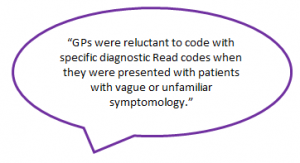Ever wondered what GPs type on the computer when they diagnose Lyme disease?
GP Coding behaviour for non-specific clinical presentations: a pilot study. Tulloch J et al BJGP Open 2020; 4 (3) 2020
When a GP sees a patient, they record their consultation on their computer system, capturing symptoms, diagnoses and therapies. These can be recorded as structured codes in agreed international formats. In the UK Read codes have been used, but SNOMED codes are now replacing them. The codes can be used in research to understand the incidence of diseases, by searching large numbers of GP databases. However, it is important when using the codes for research, to understand the process by which GPs decide on which codes to capture.
This study run by University of Liverpool, investigated the process by which GPs code their cases when presented with Lyme disease symptoms. The GPs were informed this was a study to understand the decision-making process but were not told about the Lyme disease diagnosis. Eleven cases were presented, based on real Lyme disease cases, which consisted of symptoms that could have a variety of other causes. The study was conducted by interviewing participating GPs where they were able to provide discrete responses (code information), they were then asked to expand on their reasoning. They were asked to provide their responses based on their normal coding and case management practices.
Eight GPs participated, out of which four completed all cases, three completed 10 cases and one GP completed two cases. The results saw that only two cases were given a diagnostic code for Lyme disease and a further five cases recorded that Lyme disease could be a possible cause of symptoms. Predominantly, the “differential diagnosis” (possible causes) list and cases with diagnosis codes selected were different.
Interview transcripts revealed the following five themes that influenced how GPs chose their codes:
- GP personal and professional experience – whether they had seen similar cases in friends or relatives, or previously in patients.
- Clinical evidence – whether enough information was provided to provide a certain diagnosis e.g. patient history, test results etc.
- Diagnostic uncertainty – if the GP perceived an inability to provide an exact explanation.
- Professional integrity and defensive practice – carrying out the investigative process honestly, professionally and ethically and in accordance with professional guidelines and recommending further investigations to protect against complaints or litigation.
- Patient-sourced health information and beliefs – based on the patient’s understanding and values regarding a particular condition.
Of these themes, GP personal and professional experience formed the basis of the other themes.
This study shows the uncertainty associated with providing a definitive Lyme disease diagnosis code before all required clinical information is available.
This may present an additional risk when a patient presents with a circular or bullseye rash and diagnostic testing is not recommended by clinical guidelines. The delay in providing diagnosis and treatment could lead to more severe symptoms. It is also likely that health records are currently underestimating the true incidence of the condition.
However, this study was limited by its geography, having been conducted in an area of the UK with low laboratory-confirmed incidence of Lyme disease, therefore GPs were less likely to have been presented with what is perceived to be a rare disease. This may have contributed to the reluctance in diagnostic coding.

 Printer Friendly
Printer Friendly